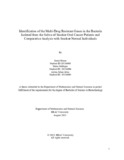Identification of the multi-drug resistant genes in the bacteria isolated from the saliva of smoker oral cancer patients and comparative analysis with smoker normal individuals
Abstract
Cancer poses a severe threat to world health in the modern period. Cancer is abnormal cell proliferation that can affect different bodily components. Due to cultural behaviors like tobacco consumption and betel nut chewing, in south Asian countries like Bangladesh, oral cancer is one of the most common types of cancer. Moreover, oral cancer is the 13th most prevalent cancer globally among different types of cancers, and the number of affected people is increasing yearly. In Bangladesh, oral cancer is the second most prevalent cancer in males and the third most prevalent in females. Patients with oral cancer often experience reduced immune systems, further weakened by cancer treatments. As a result, these individuals are at a heightened risk of multi-drug-resistant bacterial colonization and subsequent infection. In this study, microbes were identified and isolated from preoperative oral cancer patients associated with smoking tobacco consumption. Their resistance profile with the standard antibiotics used was determined, and ESBL genes' presence among these microbes was evaluated. To identify the presence of opportunistic organisms, oral swab samples are taken from 40 preoperative oral cancer patients with a significant history of smoking and 40 healthy individuals who were regular smokers. After screening from the patient group, 68 (57.14%) of the organism were gram-negative bacteria, and 51(45.86%) were gram-positive bacteria, where the most prevalent organisms were Staphylococcus spp. 27 (22.69%), followed by Klebsiella spp. 26 ( 21.85%), Pseudomonas spp. 23 (19.32%), Streptococcus spp. 17(14.29%), Proteus spp. 13 (10.92%), Enterococcus spp. 7(5.88%). The least prevalent was Escherichia spp. 6 (5.04%). In the control group, the most prevalent organism was Staphylococcus spp 19 (27.94%), and the least prevalent was Proteus spp, as no isolates of proteus were found. In the control group, the second highest organisms were Streptococcus spp 16(23.53%), followed by Klebsiella spp 15( 22.06%), Pseudomonas spp 9 (13.23%), Escherichia spp 7 (10.29%) and Enterococcus spp 2 (2.94%).
Subsequently, the isolates were all taken for antibiotic sensitivity testing (AST) against antibiotics from 11 different groups used in hospitals. It was observed that gram-positive isolates of the patient group exhibited 100% resistance to antibiotic amoxicillin, cloxacillin, and oxacillin. The gram-negative isolates exhibited 100% resistance to vancomycin, amoxicillin, and penicillin. Even though all the isolates from the patient group showed some percentage of resistance toward the antibiotics, the gram-positive isolates did not show any resistance towards the antibiotic imipenem. Moreover, both gram-positive and gram-negative isolates of the patient group exhibited high resistance to amoxicillin, and the least resistance was seen against amikacin, gentamicin, imipenem, and ciprofloxacin.
In contrast, the microbes of the control group showed less resistance to these antibiotics and showed comparatively higher sensitivity to them. Furthermore, to determine whether or not these organisms have any genes for antibiotic resistance, PCR was done to find six distinct ESBL genes NDM, bla-NDM, SHV, bla-CTX-M, bla-TEM, and bla-IMP. Of the total of these six ESBL genes examined, three genes (NDM, bla-NDM-1, and bla-IMP) were detected in different organisms in different numbers in this study.

